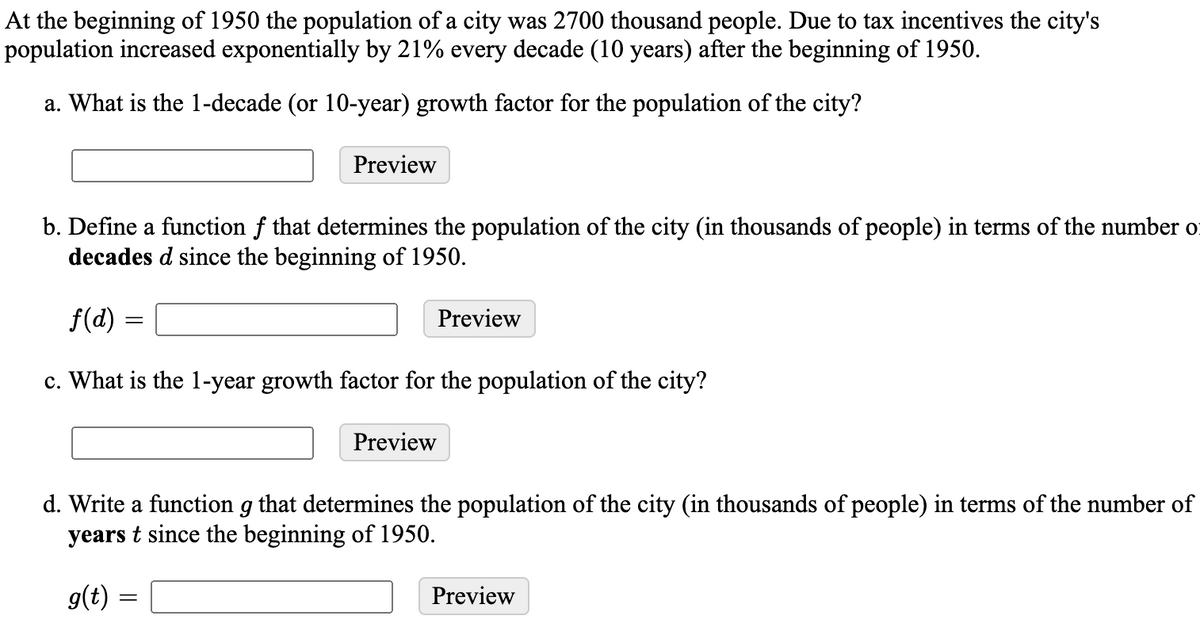At the beginning of 1950 the population of a city was 2700 thousand people. Due to tax incentives the city's population increased exponentially by 21% every decade (10 years) after the beginning of 1950. a. What is the 1-decade (or 10-year) growth factor for the population of the city? Preview b. Define a function f that determines the population of the city (in thousands of people) in terms of the number o decades d since the beginning of 1950. f(d) Preview c. What is the 1-year growth factor for the population of the city? Preview d. Write a function g that determines the population of the city (in thousands of people) in terms of the number of years t since the beginning of 1950. g(t) Preview
At the beginning of 1950 the population of a city was 2700 thousand people. Due to tax incentives the city's population increased exponentially by 21% every decade (10 years) after the beginning of 1950. a. What is the 1-decade (or 10-year) growth factor for the population of the city? Preview b. Define a function f that determines the population of the city (in thousands of people) in terms of the number o decades d since the beginning of 1950. f(d) Preview c. What is the 1-year growth factor for the population of the city? Preview d. Write a function g that determines the population of the city (in thousands of people) in terms of the number of years t since the beginning of 1950. g(t) Preview
Glencoe Algebra 1, Student Edition, 9780079039897, 0079039898, 2018
18th Edition
ISBN:9780079039897
Author:Carter
Publisher:Carter
Chapter7: Exponents And Exponential Functions
Section7.8: Transforming Exponential Expressions
Problem 1CYU
Related questions
Question

Transcribed Image Text:At the beginning of 1950 the population of a city was 2700 thousand people. Due to tax incentives the city's
population increased exponentially by 21% every decade (10 years) after the beginning of 1950.
a. What is the 1-decade (or 10-year) growth factor for the population of the city?
Preview
b. Define a function f that determines the population of the city (in thousands of people) in terms of the number of
decades d since the beginning of 1950.
f(d) =
Preview
c. What is the 1-year growth factor for the population of the city?
Preview
d. Write a function g that determines the population of the city (in thousands of people) in terms of the number of
years t since the beginning of 1950.
g(t) =
Preview
Expert Solution
This question has been solved!
Explore an expertly crafted, step-by-step solution for a thorough understanding of key concepts.
This is a popular solution!
Trending now
This is a popular solution!
Step by step
Solved in 2 steps with 2 images

Knowledge Booster
Learn more about
Need a deep-dive on the concept behind this application? Look no further. Learn more about this topic, algebra and related others by exploring similar questions and additional content below.Recommended textbooks for you

Glencoe Algebra 1, Student Edition, 9780079039897…
Algebra
ISBN:
9780079039897
Author:
Carter
Publisher:
McGraw Hill


Algebra & Trigonometry with Analytic Geometry
Algebra
ISBN:
9781133382119
Author:
Swokowski
Publisher:
Cengage

Glencoe Algebra 1, Student Edition, 9780079039897…
Algebra
ISBN:
9780079039897
Author:
Carter
Publisher:
McGraw Hill


Algebra & Trigonometry with Analytic Geometry
Algebra
ISBN:
9781133382119
Author:
Swokowski
Publisher:
Cengage

College Algebra
Algebra
ISBN:
9781305115545
Author:
James Stewart, Lothar Redlin, Saleem Watson
Publisher:
Cengage Learning